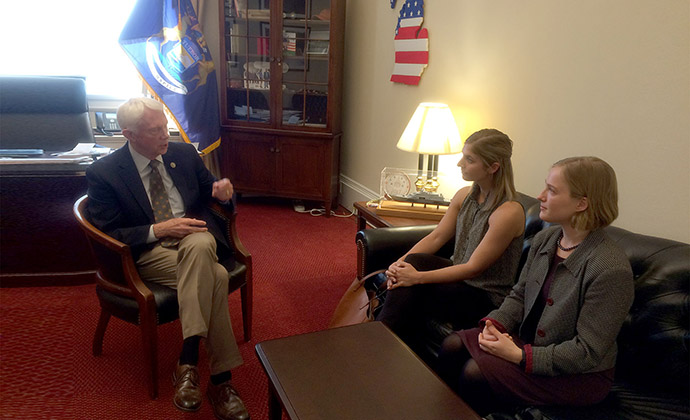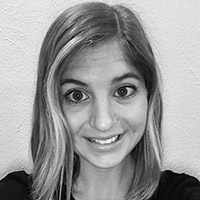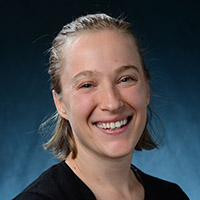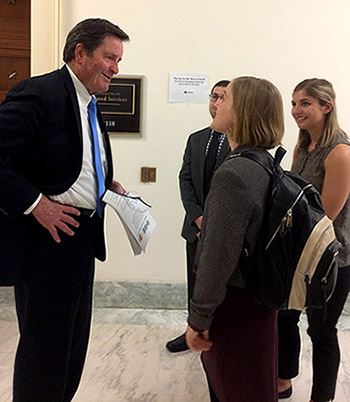AAAS “CASE” Workshop Reflections |
|
2017 AAAS “CASE” Workshop Competition winners Caroline Havrilla and Adalyn Fyhrie meet with U.S. Congressman Jack Bergman (from Michigan). Photo: Heather Bené. |
|
Each year CSTPR hosts a competition to send two CU Boulder students to Washington, D.C. to attend the AAAS “Catalyzing Advocacy in Science and Engineering” workshop. During the workshop portion, the winners learned about the structure and organization of Congress, the federal budget and appropriations processes, and tools for effective science communication and civic engagement. In addition, the winners participated in interactive seminars about policy-making and communication. Below are comments by Caroline Havrilla about this year’s workshop:
One consistent message throughout the workshop was the important distinction between “policy for science” and “science for policy.” Policy for science mostly refers to the federal budget process and the allocation of federal funds to scientific research and development. Science for policy, on the other hand, is the process whereby scientists communicate science to policymakers to inform policy-making. During the CASE workshop, my cohort first learned about policy for science, mainly focusing on the many challenges of the federal budget process, and how these challenges impact science. One particularly striking issue we were exposed to concerned the balance, or perhaps more fittingly, the imbalance, between mandatory and discretionary spending in the US federal budget. Mandatory spending, comprised of entitlement programs like Medicare, Medicaid, and Social Security, makes up about two thirds of the circa $4.1 trillion US federal budget. Discretionary spending on the other hand, makes up only a third of the federal budget. Because there is bipartisan opposition to cutting entitlement programs, when the budget needs to be trimmed, cuts are made to the non-defense discretionary budget, which is already a fairly small slice of the budgetary pie. Unfortunately, this is the category which funding for scientific organizations like NSF, NASA, and the EPA fall, making those programs vulnerable to budget cuts when their activities are not deemed “necessary” spending. For me, learning about this aspect of the federal budget process brought into perspective the overarching challenges of continued federal science funding, and made it clear that effective advocacy for science is critical. After learning about the intricacies of policy for science, we turned our focus science for policy, and how to become more effective science communicators. According to many of the science policy officials we met with in Washington, scientists often miss out on valuable opportunities to effectively communicate their science for policy because their messages often misalign with the needs of policymakers. This misalignment often results from fundamental differences in what information science and policy spheres incorporate into their decision making processes. Policymakers often make decisions based on big-picture, culturally-based value systems, while, in contrast, scientists typically make decisions based on highly specific, data-based evidence. Scientists can more effectively communicate with policymakers by 1) recognizing this communication barrier exists, and 2) incorporating storytelling and discussions of the applications and benefits of their research to addressing broader societal issues. Science is only one small piece of the decision making process, but by aligning research to economic, environmental, and societal outcomes, we can better advocate for incorporation of science into policymaking. On Hill Visit Day, the last day of the CASE workshop, my cohort members and I had the incredible opportunity to visit the Hill and advocate for scientific research with Congressional members and their staffers. With the help of the AAAS staff and our Hill guide, Heather Bené (staff member at CU’s Office of Government Relations), we had the opportunity to practice communicating our science and advocating for the incorporation of basic and applied scientific research into policymaking. I am tremendously thankful to the University of Colorado Center for Science and Technology Policy Research (CSTPR), the Center for STEM Learning, and Graduate School for sponsoring my participation in the CASE workshop and look forward to incorporating science policy in my future career. |
|
The following are comments by Adalyn Fyhrie about this year’s workshop:
|
|
I was impressed to learn about the breadth of science policy that is present in our nation’s capitol. For starters, “science policy” has different definitions - there is science for policy (using science to make policy decisions that are backed by scientific facts) and policy for science (making policy that provides scientific funding and support for research and development). The CASE workshop focused on policy for science, how it is made, and how to advocate for it. The workshop also exposed me to the wide variety of people who contribute to policy for science. Going in, I knew that members of Congress were important to science policy (they are the ones making the policies, after all), but the CASE workshop demonstrated that they are just the tip of the iceberg. Among many other contributors, there are also scientists who are employed to provide reports and briefings on science-related matters for members of government, employees of national science agencies, and scientists who come for a single day to advocate for science funding. During the CASE workshop I fit into the final category (scientist/advocate), but I had a lot of learning to do before I felt ready to meet with our members of Congress and their staff on the final day of the workshop. |
Competition winners Caroline Havrilla and Adalyn Fyhrie meet with U.S. Congressman John Garamendi (from California). |
In order to effectively advocate for policy for science, we had to first understand how policy is made and the essence of the mechanics of government. The two biggest takeaways for me were: first, that government doesn’t work the way it appears to in the news or during election time (it is, in general, much less partisan). Second, that governance is much more emotional than logical (stories can be more effective than facts). Honestly, these were counterintuitive to me, especially the importance of stories instead of facts in getting policy to pass. Many scientists (and I am no exception) want to solve problems with logic and facts, but this is not the most effective way to advocate for science and science funding to Congress. People respond to stories, and that is what we had to deliver. I started the workshop with a tenuous idea of what science policy was and how one could get involved with it as a career. By the last day, I was meeting with members of Congress and their staff and requesting continued funding of the sciences in the upcoming budget. The CASE workshop gave me confidence in my abilities as a science advocate and insight into the myriad of career options in science policy. |
|



 Participating in the 2017 AAAS Catalyzing Advocacy in Science and Engineering (CASE) Workshop in Washington, D.C. was a truly transformative experience for me as a scientist. The three-day workshop was a thought-provoking crash course in science policy, in the company of a diverse cohort of scientists from around the country, and exposed me to the complex world of policymaking. Each day of the workshop was jam-packed with a cohesive line-up of sessions with talks from speakers who shared with us their expertise on a wide range of topics in science policy. We learned about policymaking, the federal budget process, and importantly, how scientists can advocate for science and contribute to decision making within the science policy realm.
Participating in the 2017 AAAS Catalyzing Advocacy in Science and Engineering (CASE) Workshop in Washington, D.C. was a truly transformative experience for me as a scientist. The three-day workshop was a thought-provoking crash course in science policy, in the company of a diverse cohort of scientists from around the country, and exposed me to the complex world of policymaking. Each day of the workshop was jam-packed with a cohesive line-up of sessions with talks from speakers who shared with us their expertise on a wide range of topics in science policy. We learned about policymaking, the federal budget process, and importantly, how scientists can advocate for science and contribute to decision making within the science policy realm. I reached the end of two and a half days invigorated, inspired, and exhausted. I left with more questions than I had arrived with, which I took as a sign of the intensity and breadth of knowledge that I had been exposed to. The CASE workshop provided discussions with an impressive lineup of experts in the field of science policy, from members of Congress to employees of national science agencies. Each moment and every speaker was an opportunity to crack the world of science policy open and I was not about to let that chance go to waste.
I reached the end of two and a half days invigorated, inspired, and exhausted. I left with more questions than I had arrived with, which I took as a sign of the intensity and breadth of knowledge that I had been exposed to. The CASE workshop provided discussions with an impressive lineup of experts in the field of science policy, from members of Congress to employees of national science agencies. Each moment and every speaker was an opportunity to crack the world of science policy open and I was not about to let that chance go to waste.